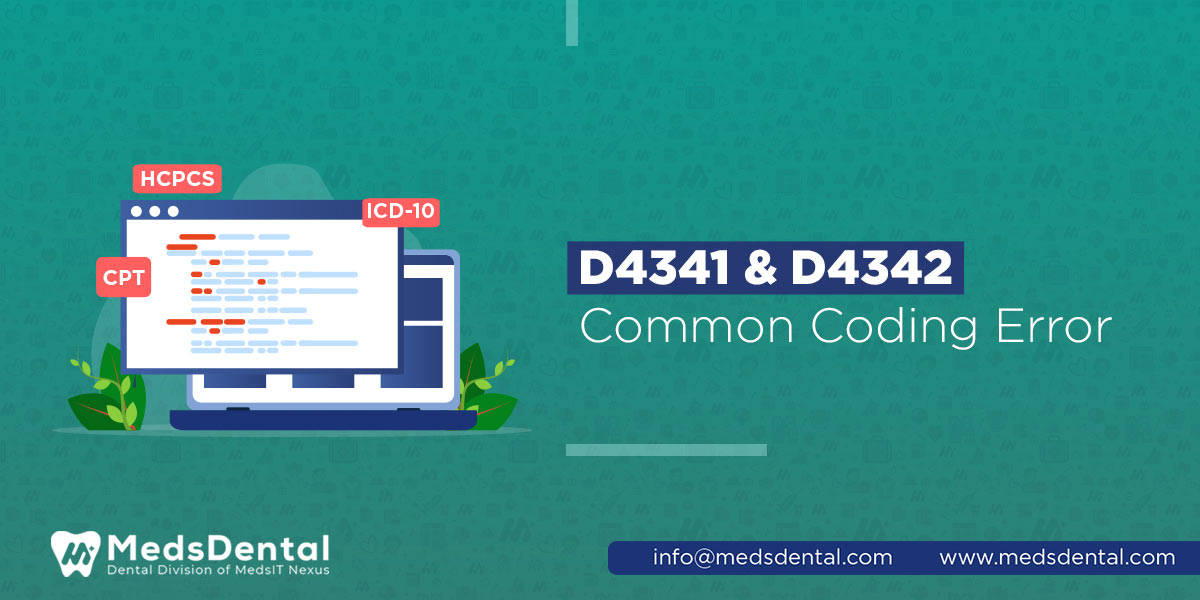

Dental coding, like many specialized coding systems, has seen a rise in complexity over time. This complexity often leads to confusion and errors, particularly with closely resembling codes. One common area of confusion revolves around codes D4341 and D4342, which pertain to extensive and localized dental treatments, respectively. Misapplication of these codes can result in claim denials and reimbursement issues for dental practices. Thus, dental professionals must understand the nuances between these codes to document and code for the treatments provided accurately. In this blog, we will discuss the difference between the D4341 & D4342-codes, common coding errors in billing them, and how to avoid these errors.
While billing D4341 and D4342, it is paramount for a dental billing and coding company to accurately understand the difference between the application of these two codes to receive reimbursement and avoid potential claim denials. The core difference is the intensity of the treatment rendered and the number of teeth involved. Dental code D4341 is used for more comprehensive cases involving around four or more teeth per quadrant, referring to a broader area of periodontal disease requiring more extensive procedures. Meanwhile, D4342 is used in cases that involve one to three teeth per quadrant. Contrary to the D4341, dental code D4342 indicates utilization of a more targeted approach to treat a localized area's periodontal disease or targeted deep cleaning of a few specific teeth. Misinterpreting or misapplying these decisive dental codes can lead to claim denials and maybe to audits that can result in legal liabilities.
In this section, we will discuss some of the most prevalent coding errors that professionals commit while billing dental codes D4341 & D4342
Coding errors resulting from misinterpreting quadrant versus tooth numbers can lead to rejecting claim denials. This impacts the financial flow of a dental practice concerning particular procedures such as scaling and root planing (D4341 and D4342). If a dentist wishes to apply the dental code D4341, they need to state the quadrant requiring a comprehensive treatment nature precisely. If one needs to specify quadrants and instead bills with individual tooth numbers, this can lead to claim denial or reduced reimbursement. This is because a provider may view it as malpractice done to inflate claims or purposefully misrepresent the treatment provided. Similarly, when it comes to using D4342, specifying the teeth in a quadrant is essential. Only selecting the quadrant will not suffice and might result in a denied claim.
One of the most prevalent coding errors is applying an irrelevant code altogether. This has more chances to occur, primarily when an inexperienced head deals with complicated and closely resembling dental codes such as D4341 and D4342. This error can result from a lapse on the part of the coder or a coding staff that is unfamiliar with the latest guidelines. Coding staff often misinterprets the dental codes, using D4341 instead of D4342, which depicts localized treatment, leading to inflated bills. Eradicating the root cause of the error is essential, as the payer may deem it a fraudulent activity. It might be deemed upcoding as the dental practice will charge for a more expensive process that was never rendered.
Insurance providers often demand solid evidence from dental practice to back their decision to perform scaling and root planing. This may include evidence of bone loss and clear X-rays showcasing affected areas. Failing to provide such evidence would result in claim denial. If a practice wishes to apply D4341 or D4342, they need to document the quadrants and teeth involved in a dental procedure. Insurance providers also typically require periapical or bitewing X-rays to validate bone loss and justify the necessity of scaling and root planing. These X-rays provide detailed images of the teeth and surrounding bone structures, allowing dental professionals to assess the extent of bone loss associated with periodontal disease.
Insurance companies might ask for proof of appointment length. This request is made in order to verify that one has spent enough time on a patient that reflects the complexity and intensity of procedures coded using dental codes D4341 and D4342. For instance, the lengthy time indicates that the dentist has spent ample time on patients to clean and treat the teeth and gum thoroughly. This is crucial in cases that involve all four quadrants. Penning down the appointment length depicts that dental practice has lived up to the established standards of care and is worthy of receiving reimbursement against the submitted codes.
To avoid coding errors in billing D4341 and D4342, consider the following tips
Are you fed up with facing claim denial on a consistent basis? If yes, then contact MedsDental, a dental billing and coding solution, with an answer to all your problems. We provide you with a coding staff that is keen on detail and seldom commits an error. Our dedicated teams constantly communicate with top insurance providers to keep pace with changing guidelines. Our low claim denial ratio reflects our commitment, dedication and customer-first approach. MedsDental is here to dash any obstacle holding your dental practice from achieving sustainable success.
© MedsDental. All rights reserved 2026. Powered by MeshSq.